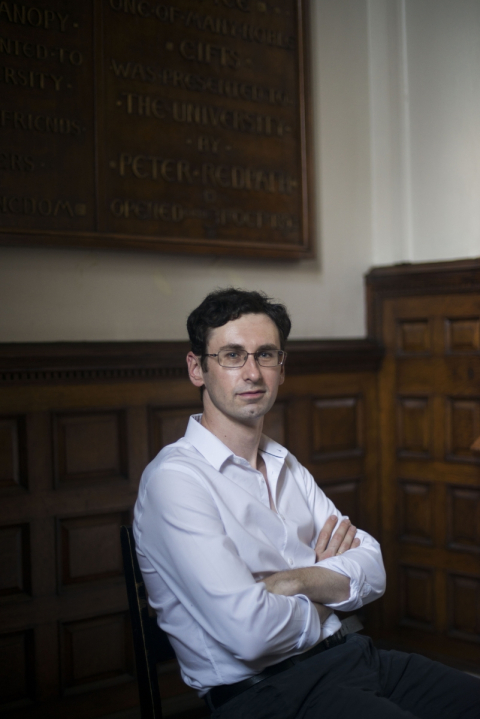Ilya Poletaev on Chopin: "The kinetic, the musical, and the emotional are all one"

Well-known for his focus on the works of George Enescu (recordings of which the American Record Guide proclaimed to be some of the “finest readings” of the music), as well as for his versatility and expertise on period instruments, pianist Prof. Ilya Poletaev is equally at home interpreting the music of other master composers. Slated to appear with the McGill Symphony Orchestra (MGSO) in their opening concert of the season, Poletaev will perform Chopin’s Piano Concerto No. 1 on Sept. 21 and 22 in Pollack Hall and on Sept. 23 at Kingston’s Isabel Bader Centre for the Performing Arts. We got in touch with Poletaev in a recent email interview to discuss the concerto and more.
What are your thoughts on Chopin’s 1st piano concerto? How does it compare to those written by his peers (for example, Liszt or Mendelssohn)?
Despite being labeled as No. 1, the E minor Concerto is actually the second piano concerto that Chopin wrote (due to it being published before the more rhapsodic and formally much more loose concerto in F minor), and it’s a remarkable work on many counts.
First of all, the piece’s form is very Classical, though with some unorthodox touches (the parallel major section doesn’t arrive until the recapitulation!), and the orchestra plays a significant role in the work. Schumann wrote that in this work, Chopin evokes the spirit of Beethoven, and one can certainly understand why. There’s a real symphonic dimension and scope to the piece – not to mention a clear reference to Beethoven’s Sonata op. 90, which is also in E minor! There’s also no lengthy cadenza and it’s not experimental in form, like Liszt’s piano concerti, nor is it divertimento-like, which one often feels with the shorter Mendelssohn concerti, as wonderful as they are.
By the way, I don’t agree that Chopin was a poor orchestrator, or that he didn’t concern himself much with the orchestral part. I find that there is a lot of depth and care in the way that the score is put together, but it needs a sympathetic, intelligent, and very refined ear to bring out certain nuances and imaginative touches that can easily get lost (woodwind solos, among others!) Of course, Chopin had a much smaller ensemble and a very different kind of piano, so we must keep this in mind when we perform it today on modern instruments. I’m therefore very fortunate and grateful to have a chance to collaborate with Maestro Hauser on this very well-known, but often rather carelessly treated score, which we both love and respect tremendously.
For this performance, we’ll be using the 2005 Polish National Edition, which has restored Chopin’s original thoughts about the orchestration. There are numerous differences, above all in the orchestral parts, from what one normally hears, and we are both really looking forward to this “cleaned-up” Chopin, free of later editorial accretions. Maestro Hauser spent countless hours on bowings and the librarians on correcting the parts, to make sure that the orchestral materials that we’ll be performing are fully updated.
As a piano professor here at Schulich, what advice would you give students who are learning to play this concerto?
This is a piece I’ve taught a number of times and I find that it’s an amazing gateway into Chopin’s thinking, especially in terms of understanding certain key precepts of Chopin’s pianistic idiom and his way of handling the keyboard. There is an amazing unity between Chopin’s own way of playing the piano, the nature of the musical material, and the effect that it produces – the kinetic, the musical, and the emotional are all one. Also, I believe that this is one of the pieces in which Chopin is at his most vulnerable and emotionally exposed, especially in the first two movements. It requires the utmost sincerity and involvement, a kind of purity that takes a lot out of the performer.
My own approach to performing the piece is shaped in part through my training in the hands of my incomparable former professor at the University of Toronto, Marietta Orlov, who is Canada's pre-eminent piano pedagogue. She studied this concerto in Romania with Florica Musicescu, the teacher of Dinu Lipatti, and has performed it extensively. Without ever hoping to match Lipatti’s perfection, I aspire to some of the same ideals – a Classical clarity of articulation, a very vocal, horizontal, polyphonic thinking coupled with Romantic warmth of feeling and nobility of tone and expression. I seek to pass on these values to my students, and I also try to apply them to my performance of this work.
How does it feel to be a soloist with the MGSO in their first concert of the year?
Exhilarating and humbling! I am on half-sabbatical this term, which means that I unfortunately will miss the large piano homecoming event in October. I am grateful for this opportunity to contribute to the proceedings and to represent our very strong department through this performance!
Hear the McGill Symphony Orchestra perform Chopin’s Piano Concerto No. 1, Dvorak’s Carnival Overture and Brahms’ Symphony No. 4 in E minor on September 21 and 22 in Pollack Hall. Tickets can be purchased here.
The MGSO will also perform the program on September 23 at Kingston’s Isabel Bader Centre for the Performing Arts.

